Seeing and Sensing the Presence of Fish
Too many fly fishers concentrate on seeing a fish and not “sensing” the presence of fish. Truly successful fly fishers don’t just look for a fish but all the subtle sights and sounds of where the fish are. The less blind fishing you can do and the more targeted casts you make the more fish you will probably catch.
Before even heading for the stream it is critical that you have a good pair of polarizing sunglasses. For a more comprehensive review of the value of sunglasses and what to look for in a pair refer to our Tips & Techniques article on sunglasses.
See Norm's recommendations for fly fishing sunglasses
OK, so you have your copper tinted glasses with a good side shield. Now you will suddenly see fish. Not! Now it is a question of where to look, how to look, and what to look for.
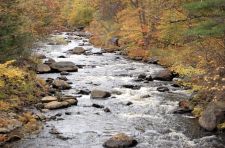 Fishing legend says that the English don’t wade, fish in tweed and only cast to rising fish. Maybe on a smooth flowing chalk stream you can see the rises and know something is hatching. But on a high gradient stream it isn’t always easy to see a rise, to know if a hatch is going on and if there is a hatch what group is hatching. If you can determine that there is a hatch, spotting rising fish becomes a bit easier. As you fish your way up the stream keep looking out over the water a little below tree top level. Why do this? When there is a hatch of any significance at all, the flycatcher swallows and all the other birds will be darting out of the stream to take advantage of the feast. How the birds are flying will also give you a lot of insight into what pattern to tie on to prospect with. If the bird’s flight is straight out and back to a perch on a branch, more than likely mayflies are hatching. If they are making a low erratic flight over the water, a size 14 tan elk hair caddis would be a good choice.
Fishing legend says that the English don’t wade, fish in tweed and only cast to rising fish. Maybe on a smooth flowing chalk stream you can see the rises and know something is hatching. But on a high gradient stream it isn’t always easy to see a rise, to know if a hatch is going on and if there is a hatch what group is hatching. If you can determine that there is a hatch, spotting rising fish becomes a bit easier. As you fish your way up the stream keep looking out over the water a little below tree top level. Why do this? When there is a hatch of any significance at all, the flycatcher swallows and all the other birds will be darting out of the stream to take advantage of the feast. How the birds are flying will also give you a lot of insight into what pattern to tie on to prospect with. If the bird’s flight is straight out and back to a perch on a branch, more than likely mayflies are hatching. If they are making a low erratic flight over the water, a size 14 tan elk hair caddis would be a good choice.
Splatter Vision
As you drive down the highway you don’t fix your focus on the road just in front of you. You are continuously scanning the environment. You are looking several cars ahead of you, in your rear view mirror, and at the gages on the dashboard. When something catches your eye – break light on a car up ahead, an exit sign or the flashing lights of the police in your rear view mirror – you immediately focus in on what caught your attention. Next you assess the situation, take appropriate action if necessary and if nothing has to be done you resume your scan. In the case of the police lights you start working on a good story.
How does this apply on the stream and in seeing fish? The same process that you employ while driving applies here. You don’t focus and look at any one thing. Instead, you are continually scanning the entire area looking at everything and key in on subtle differences such as the bird’s movement, shapes, patterns and colors.
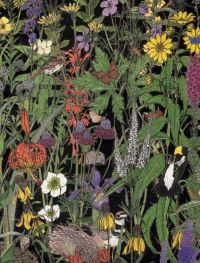 |
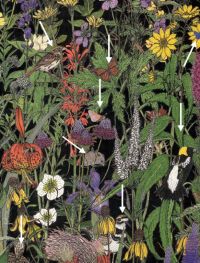 |
As these two pictures illustrate, these differences are the triggers that cause you to zoom in on what caught your eye and evaluate it.
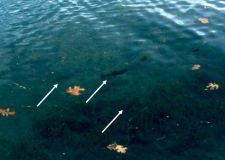 Now that you have your polarizing glasses to cut the glare and are starting to practice using “splatter vision,” what are the subtle shapes, pattern and colors to look for? Once in a while you will be lucky enough to clearly see a fish in the water. These opportunities give you valuable information about the shapes; pattern and colors that we need to look for.
Now that you have your polarizing glasses to cut the glare and are starting to practice using “splatter vision,” what are the subtle shapes, pattern and colors to look for? Once in a while you will be lucky enough to clearly see a fish in the water. These opportunities give you valuable information about the shapes; pattern and colors that we need to look for.
In most streams the predominate shape of material on the bottom will be round, oval or maybe even somewhat rectangular and not long and slender. If it is long and narrow and not rounded there is a good possibility it is a fish. Remember it is just a possibility. You could spend your time fishing to a trout sized log that you thought was a log sized trout!
 It would be nice to be able to say that fish are always going to be one color and the steam bed will always be a different color. Your prey can be anything from dark to light. The important thing is to look for a color difference and try to couple it with a difference in shape.
It would be nice to be able to say that fish are always going to be one color and the steam bed will always be a different color. Your prey can be anything from dark to light. The important thing is to look for a color difference and try to couple it with a difference in shape.
As you scan the stream looking for those tell tale shapes and color differences keep your eyes peeled for slight movements. Your fish may have the same shape and color of the material as the location where he is holding. The slight movement of a fin or the flash of white as he opens his mouth to feed may be all you have to go on. Look hard for those subtle signals and you will see your fish.
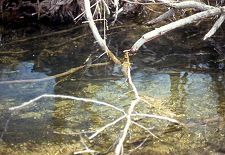 So the next time you are driving down the highway in your fashionable polarizing sunglasses on your way to your favorite stream, practicing splatter vision, think about where you have caught fish. When you get to the stream look in those places for signs of a fish shape, color and movement.
So the next time you are driving down the highway in your fashionable polarizing sunglasses on your way to your favorite stream, practicing splatter vision, think about where you have caught fish. When you get to the stream look in those places for signs of a fish shape, color and movement.